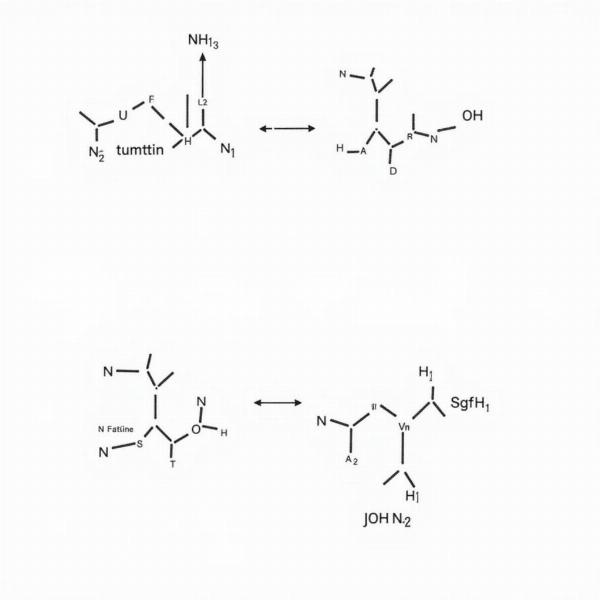Lone pairs are a fundamental concept in chemistry, crucial for understanding molecular geometry and reactivity. If you’re searching for “lone pair meaning in Hindi,” you’ve come to the right place. This guide will delve into the meaning, importance, and implications of lone pairs, providing clear explanations and relatable examples.
Understanding Lone Pairs: एकल युग्म क्या हैं?
A lone pair, also known as a non-bonding pair, refers to a pair of valence electrons that are not shared with another atom in a covalent bond. They reside in the outermost electron shell of an atom and influence the molecule’s shape, polarity, and reactivity. In Hindi, lone pair is often referred to as “एकल युग्म” (ekal yugm), which literally translates to “single pair.”
Why are Lone Pairs Important?
Lone pairs play a significant role in determining the three-dimensional shape of a molecule. They exert repulsive forces on the bonding pairs of electrons, leading to distortions in the ideal bond angles predicted by the VSEPR (Valence Shell Electron Pair Repulsion) theory. This repulsion is stronger than the repulsion between bonding pairs.
For instance, consider water (H₂O). The oxygen atom has two lone pairs and two bonding pairs. The lone pairs repel the bonding pairs, causing the H-O-H bond angle to be less than the ideal 109.5 degrees, resulting in a bent molecular geometry.
Lone Pairs and Chemical Reactivity
The presence of lone pairs greatly influences a molecule’s chemical reactivity. Molecules with lone pairs can act as Lewis bases, meaning they can donate their lone pair electrons to form a coordinate covalent bond with a Lewis acid (an electron-pair acceptor). This makes them important participants in various chemical reactions. For example, ammonia (NH₃) with its lone pair on nitrogen readily reacts with acids.
Lone Pair Examples in Common Molecules
Several common molecules exhibit lone pairs. Understanding their presence and influence is key to grasping their chemical behavior. Here are a few examples:
- Ammonia (NH₃): Nitrogen has one lone pair.
- Water (H₂O): Oxygen has two lone pairs.
- Hydrogen Sulfide (H₂S): Sulfur has two lone pairs.
- Carbon Monoxide (CO): Oxygen has one lone pair and carbon has one lone pair. Both contribute to the reactivity of this poisonous molecule.
 Ammonia and Hydrogen Sulfide Lone Pairs
Ammonia and Hydrogen Sulfide Lone Pairs
Lone Pairs and Hybridization
Hybridization is a concept that explains the mixing of atomic orbitals to form new hybrid orbitals that participate in bonding. Lone pairs also occupy hybrid orbitals and influence the overall hybridization state of an atom.
What if a molecule has more than one lone pair?
If a molecule has multiple lone pairs, the repulsive forces between them are significant, leading to further distortions in bond angles and influencing molecular geometry.
Expert Insight: Dr. Anjali Sharma, a renowned chemist from IIT Delhi, explains, “Lone pairs, though unseen, are the silent architects of a molecule’s shape and reactivity. Understanding their influence is fundamental to comprehending chemical behavior.”
Conclusion: The Significance of Lone Pairs
Understanding “lone pair meaning in Hindi” (एकल युग्म का अर्थ) is essential for anyone studying chemistry. These non-bonding electron pairs significantly impact molecular geometry, polarity, and reactivity. From the bent shape of water to the reactivity of ammonia, lone pairs play a crucial role in the behavior of countless molecules. Mastering this concept unlocks a deeper understanding of the fascinating world of chemical interactions.
FAQ: Frequently Asked Questions about Lone Pairs
- What is the difference between a bonding pair and a lone pair? A bonding pair is shared between two atoms in a covalent bond, while a lone pair is not shared.
- How do lone pairs affect bond angles? Lone pairs exert greater repulsive forces than bonding pairs, decreasing bond angles.
- Why are lone pairs important in chemical reactions? Lone pairs can be donated to form coordinate covalent bonds, making molecules with lone pairs act as Lewis bases.
- Can lone pairs participate in hybridization? Yes, lone pairs occupy hybrid orbitals and influence the hybridization state of an atom.
- Do all atoms have lone pairs? No, only atoms with valence electrons that are not involved in bonding have lone pairs.
- How can I identify the number of lone pairs on an atom? Use the Lewis structure to visualize the valence electrons and identify lone pairs.
- What is the Hindi word for lone pair? Lone pair is often referred to as “एकल युग्म” (ekal yugm) in Hindi.
Related Articles
You might find these articles helpful:
Meaning-Hindi.in: Your Trusted Partner for Hindi Translations
Meaning-Hindi.in specializes in providing accurate and culturally sensitive Hindi translation services. We cover a wide range of domains, including business, legal, technical, website localization, educational, and specialized content. Our expert translators ensure your message resonates effectively with your target audience. Contact us today for professional Hindi translation solutions.
Email: [email protected]
Phone: +91 11-4502-7584
Contact us at Meaning-Hindi.in for all your Hindi translation needs.